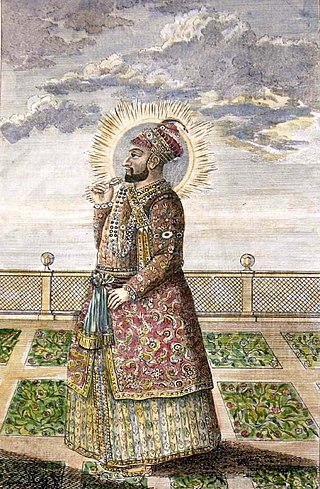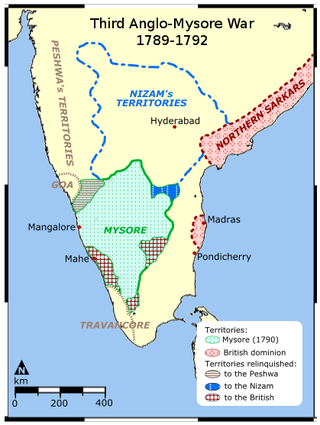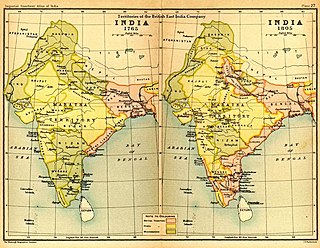
Tipu Sultan, commonly referred to as Sher-e-Mysore or "Tiger of Mysore", was the Indian Muslim ruler of the Kingdom of Mysore based in South India. He was a pioneer of rocket artillery. He introduced a number of administrative innovations during his rule, including a new coinage system and calendar, and a new land revenue system, which initiated the growth of the Mysore silk industry. Tipu was also a pioneer in introducing Channapatna toys. He expanded the iron-cased Mysorean rockets and commissioned the military manual Fathul Mujahidin. He deployed the rockets against advances of British forces and their allies during the Anglo-Mysore Wars, including the Battle of Pollilur and Siege of Srirangapatna.

Hyder Ali was the Sultan and de facto ruler of the Kingdom of Mysore in southern India. Born as Hyder Ali, he distinguished himself as a soldier, eventually drawing the attention of Mysore's rulers. Rising to the post of Dalavayi (commander-in-chief) to Krishnaraja Wodeyar II, he came to dominate the titular monarch and the Mysore government. He became the de facto ruler of Mysore as Sarvadhikari by 1761. During intermittent conflicts against the East India Company during the First and Second Anglo–Mysore Wars, Hyder Ali was the military leader.

The Maratha Empire was an early modern Indian empire and later a confederation that controlled large portions of the Indian subcontinent in the 18th century. Maratha rule formally began in 1674 with the coronation of Shivaji of the Bhonsle dynasty as the Chhatrapati. Although Shivaji came from the Maratha caste, the Maratha empire also included warriors, administrators, and other nobles from the Maratha and several other castes from what is known today as Maharashtra. The Maratha Kingdom was expanded into a full-fledged Empire in the 18th Century under the leadership of Peshwa Bajirao I.

The Kingdom of Mysore was a realm in the southern part of Deccan Plateau traditionally believed to have been founded in 1399 by two Hindu brothers, in the vicinity of the modern city of Mysore. From 1799 until 1950, it was a princely state, until 1947 in a subsidiary alliance with British India. The British took direct control over the princely state in 1831. Upon accession to the Dominion of India, it became Mysore State, later uniting with other Kannada speaking regions to form the state of Karnataka, with its ruler remaining as Rajapramukh until 1956, when he became the first governor of the reformed state.

The Second Anglo-Mysore War was a conflict between the Kingdom of Mysore and the British East India Company from 1780 to 1784. At the time, Mysore was a key French ally in India, and the conflict between Britain against the French and Dutch in the American Revolutionary War influenced Anglo-Mysorean hostilities in India. The great majority of soldiers on the company side were raised, trained, paid and commanded by the company, not the British government. However, the company's operations were also bolstered by Crown troops sent from Great Britain, and by troops from Hanover, which was also ruled by Great Britain's King George III.

The First Anglo-Mysore War (1767–1769) was a conflict in India between the Sultanate of Mysore and the East India Company. The war was instigated in part by the machinations of Asaf Jah II, the Nizam of Hyderabad, who sought to divert the company's resources from attempts to gain control over the Northern Circars.

The Anglo-Mysore Wars were a series of four wars fought during the last three decades of the 18th century between the Sultanate of Mysore on the one hand, and the British East India Company, Maratha Empire, Kingdom of Travancore, and the Kingdom of Hyderabad on the other. Hyder Ali and his succeeding son Tipu fought the wars on four fronts: with the British attacking from the west, south and east and the Nizam's forces attacking from the north. The fourth war resulted in the overthrow of the house of Hyder Ali and Tipu, and the dismantlement of Mysore to the benefit of the East India Company, which took control of much of the Indian subcontinent.

The Third Anglo-Mysore War (1790–1792) was a conflict in South India between the Kingdom of Mysore and the British East India Company, the Kingdom of Travancore, the Maratha Empire, and the Nizam of Hyderabad. It was the third of four Anglo-Mysore Wars.

The Fourth Anglo-Mysore War was a conflict in South India between the Kingdom of Mysore against the British East India Company and the Hyderabad Deccan in 1798–99.

The Maratha Conquests were a series of conquests in the Indian subcontinent which led to the building of the Maratha Empire. These conquests were started by Shivaji in 1659, from the victory at the Battle of Pratapgad against Bijapur. The expansion of the empire was limited and interrupted by the Mughal conquests of south India by Mughal ruler Aurangzeb until he eventually died in 1707 in Deccan itself. Marathas were forced to defend their territories against the overwhelmingly strong Mughal army in the 27 years long Deccan wars. They were able to defend their territories and gain an upper hand over Mughals in the sustained conflict.

Madhavrao II was the 12th Peshwa of the Maratha Empire in India, from his infancy. He was known as Sawai Madhav Rao or Madhav Rao Narayan. He was the posthumous son of Narayanrao Peshwa, murdered in 1773 on the orders of Raghunathrao. Madhavrao II was considered the legal heir, and was installed as Peshwa by the Treaty of Salbai in 1782 after First Anglo-Maratha War.
The Treaty of Mangalore was signed between Tipu Sultan and the British East India Company on 11 March 1784. It was signed in Mangalore and brought an end to the Second Anglo-Mysore War.
The Treaty of Seringapatam, signed 18 March 1792, ended the Third Anglo-Mysore War. Its signatories included Lord Cornwallis on behalf of the British East India Company, representatives of the Nizam of Hyderabad and the Maratha Empire, and Tipu Sultan, the ruler of Mysore.

The Mysorean invasion of Malabar (1766–1792) was the military invasion of the Malabar region of Kerala, including the territories of the Zamorin of Calicut, by the then-de facto ruler of the Kingdom of Mysore, Hyder Ali. After the invasion, the Kingdom of Cochin to the south of Malabar became a tributary state of Mysore.
The siege of Bahadur Benda occurred when the forces of Mysore led by Tipu Sultan besieged Bahadur fort in 1787. Tipu Sultan defeated the Maratha Army led by Hari Pant and captured the fort. It was the last military engagement between the Maratha Empire and Tipu Sultan.
The siege of Nargund took place in 1778 when troops from the Sultanate of Mysore attempted to capture the town of Nargund, a possession of the Maratha Empire. Hyder Ali defeated Marathas and captured Nargund. Hyder Ali kept its Brahmin ruler, Vyankatrao Bhave, as the ruler of Nargund as long as he paid an annual tribute.

Mudhoji I was the ruler of the Nagpur kingdom from 1772 to 1788. During his regency the Maratha kingdom remained peaceful and prospered.
Hari Pant was one of the generals of the Maratha Empire. Hari Pant became a general during the siege of Badami on 20 May 1786 against the Kingdom of Mysore. He became general of 50,000 and won the war in Maratha-Mysore War. May 1787 Hari Pant allied with the Nizam of Hyderabad With the Army Of 30,000 Maratha cavalry and 20,000 of Nizam's cavalry and soldiers against Tipu Sultan but Tipu Sultan marched towards Adoni and took Adoni Fort by surprise. September 1786 Marathas under Hari Pant reached Savanur with lack of food supplies Tipu Sultan reached 5 miles away from Savanur Tipu want a surprise attack on Maratha Army but spies of maratha told this to Hari Pant. Marathas were ready to end this surprise attack. At first, Tipu Sultan did not fire his cannons. So Hari Pant and Marathas thought that Tipu has no long range cannons. So they came near the fort, but then Tipu's Army started firing the cannons on the Maratha Army. About 7 hours later Marathas retreated on 15 October 1786. Tipu entered city of Savanur. 1 January 1787 Tipu Sultan once again attacked Maratha Army of Hari Pant Phadke which was stationed in Bahadur Benda near Gajendragad and Koppal. On 3 January Tipu besieged the fort of Bahadur Benda where Maratha Army stayed. Hari Pant decisively defeated Tipu in this war. The war ended on 10 February 1787 As Maratha victory. The kingdom of Mysore thus officially became a tributary state to the Maratha Empire. Tipu had to sign a peace agreement with Marathas and focus on British. This war end the Maratha-Mysore War in 1787. Tipu agreed to pay 12 Lakh per year to Marathas as tribute and release Kalopant. Maratha Agreed Tipu Sultan As "Naovab Tipu Sultan". Tipu Wants more focus On British not the Marathas. all territories of Marathas given to Marathas. He also participated in Third Anglo-Mysore War in 1790 alongside Parasuram Bhau. He won the respect of Nana Fadnavis And Peshwa so he give very large army of Marathas in South India expedition.

Sham Raj I ; born as Renuka Das Bhalerao,; popularly known as Raja Sham Raj Rai Rayan, was a general, a statesman, and an Indian noble who served as Prime Minister of Hyderabad. He is also known as Raja Shan Rai Rayan Renuka Das.
The second siege of Nargund was a siege conducted by Tipu Sultan, the Sultan of Mysore, in Nargund in 1785. Tipu Sultan, along with his commander, Burhanudhin, defeated the Marathas and recaptured Nargund.













